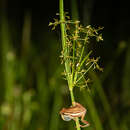Description
provided by AmphibiaWeb articles
A long, very slender savanna-living Hyperolius (males 18–24 mm) from southern Africa with longitudinal striping. Pupil horizontal.Two colour patterns exist. They may, according to Poynton and Broadley (1987), be juvenile and female phases since they note that the middorsal stripe disappears with age, without, however, stating how they determine the age of the mature males.Phase J: Dorsum with six blackish brown longitudinal stripes, separating five light bands, one middorsal, a dorsolateral pair and a lateral pair. The middorsal and lateral light stripes are grass green, as is the head, while the dorsolateral pair are light golden brown. Throat yellow, ventrum whitish, limbs and toes red.Phase F: The two central black stripes are missing, so that dorsum is uniform light green with two blackish brown stripes delimiting a green lateral stripe.Whether H. quinquevittatus really does belong to the nasutus group is not known. Poynton and Broadley (1987) think it is closer to H. kivuensis. Both subspecies of quinquevittatus are sympatric with H. nasutus. They seem to have the same male calling site and habitat requirements, but H. quinquevittatus generally occurs at higher altitudes.Two subspecies are recognised, H. q. quinquevittatus in the greater part of the range, and H. q. mertensi Poynton 1964 from the Nyika plateau in Malawi. The latter is characteristically greenish with two dark longitudinal lines on flanks. The adults of H. q. mertensi thus seems to be identical to H. q. quinquevittatus phase F in morphology and pattern, while the newly metamorphosed specimens are striped. Poynton and Broadley (1987) further mention differences in the striped juveniles of the two subspecies. According to my material the more eastern samples of H. q. quinquevittatus show a greater frequency of the phase F among males than western material from R. D. Congo, which could indicate a transition to H. q. mertensi, but Poynton and Broadley (1987) consider this doubtful.This species shows developmental changes in patterning, with two phases, J (juveniles and many mature males) and F (mature females and some mature males). All newly metamorphosed individuals are phase J, which is normally brownish to green with paired light dorsolateral lines, or an hourglass pattern. All females, and some males, develop into phase F before the first breeding season. Phase F is often colorful and variable, showing the diagnostic color characteristics for the species or subspecies. Either well-defined morphs may be present, or graded variation. This account was taken from "Treefrogs of Africa" by Arne Schiøtz with kind permission from Edition Chimaira (http://www.chimaira.de/) publishers, Frankfurt am Main.
Distribution and Habitat
provided by AmphibiaWeb articles
A savanna species. H. q. quinquevittatus is distributed in northern Angola, southern R. D. Congo, the northern half of Zambia and part of Malawi. H. q. mertensi is a savanna species from grasslands at 1800 m to 2300 m on the Nyika Plateau, northern Zambia and Malawi.
Life History, Abundance, Activity, and Special Behaviors
provided by AmphibiaWeb articles
The males call from grass stems near swampy patches. The voice is a brief unmelodic “creak” uttered singly with rather long intervals. The sonogram shows that the call consists of a small number of figures in very rapid succession.
Hyperolius quinquevittatus: Brief Summary
provided by wikipedia EN
Hyperolius quinquevittatus is a species of frog in the family Hyperoliidae. It is found in Angola, Democratic Republic of the Congo, Malawi, Tanzania, Zambia, and possibly Mozambique. Its natural habitats are moist savanna, subtropical or tropical high-altitude grassland, swamps, freshwater marshes, and intermittent freshwater marshes.
- license
- cc-by-sa-3.0
- copyright
- Wikipedia authors and editors

